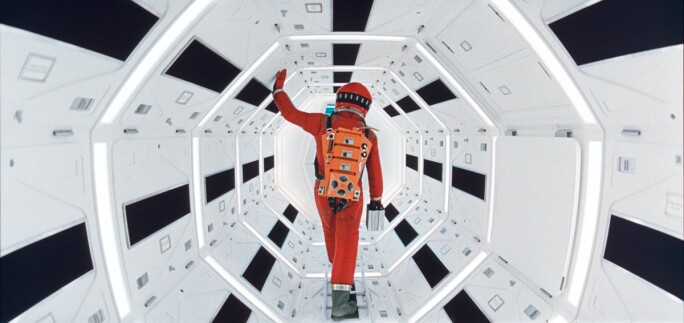
Still from Stanley Kubrick's 2001: A Space Odyssey (1968) © Warner Bros Entertainment Inc
A year before man first landed on the moon, Stanley Kubrick created a vision of space that shaped the popular imagination for decades. His science fiction epic 2001: A Space Odyssey premiered in Washington, DC on 2 April 1968 to rapturous, and lasting, acclaim. “The film has already inspired several generations of artists,” says Nils Daniel Peiler, co-curator of a new exhibition at the Deutsches Filmmuseum Frankfurt that celebrates the film’s 50th anniversary. “It has inspired not only numerous other films, TV series, music videos and commercials, but also influenced genres as diverse as literature, comics, painting, design and architecture.”

Stanley Kubrick on the set of 2001: A Space Odyssey (1968) © Warner Bros Entertainment Inc
Kubrick, who would turn 90 this year, made only 13 feature films over a career that lasted nearly half a century. Despite this, his work represents a range of interests “seldom known in film history, encompassing various genres and stories and touching the heart and the basis of human encounters”, Peiler says. His films explore the darker side of the human mind, using long, geometric shots to frame characters who are often pushed to psychological breaking point.
As a teenager Kubrick spent five years as a photojournalist at Look magazine, a now-defunct American publication that showcased scenes of everyday life. It was here that he learned how to capture the drama of human relationships, says Donald Albrecht, co-curator of 'Through a Different Lens: Stanley Kubrick Photographs', a current exhibition at the Museum of the City of New York that features more than 120 of these early photographs. “At the magazine he learns how to frame, light and compose [a shot]. They say something enduring about human interaction and human life that remains interesting,” he says.

From Life and Love on the New York City Subway, Look magazine (1947) Courtesy: Museum of the City of New York
The earliest photograph was taken when Kubrick was just 17 years old, but the images anticipate the themes and visual style that would mark his later work. “There is already the dark and voyeuristic vision of the world that you see later on [in his films],” Albrecht says. This might be catching couples in public – kissing on a bench, or falling asleep on a train – but also involved finding more illicit or taboo places to shoot. “When he goes to the Copacabana nightclub, he doesn’t just shoot the showgirls; he shoots a group of men in the foreground watching the showgirls,” Albrecht says.

Stanley Kubrick with Faye Emerson from Faye Emerson: Young Lady in a Hurry, Look magazine (1950) Courtesy: Museum of the City of New York
Kubrick never shied away from controversial issues. Films such as A Clockwork Orange and The Shining depict extreme violence, while Lolita and Eyes Wide Shut deal with dark sexual impulses. “What made him so special was his ability to tackle very difficult subjects in such a beautiful and poetic way,” says James Lavelle, curator of 2016’s Daydreaming with Stanley Kubrick at Somerset House. This exhibition featured works by contemporary artists, filmmakers and musicians inspired by the director, including a film installation by artist Doug Foster designed to provoke the same visceral response in the viewer as the “stargate” sequence in 2001: A Space Odyssey. “The way [Kubrick] intertwined visuals with his use of sound, constantly pushing our imaginations and emotions, is unparalleled,” says Lavelle.

'Daydreaming with Stanley Kubrick' at Somerset House, 6 July–24 August (2016), Courtesy of Somerset House © Peter Macdiarmid for Somerset House
For Lavelle, it is Kubrick’s grasp of the history of visual culture combined with an eye for the cutting-edge that makes him so distinctive. “He was a master at taking classic imagery and reinventing that within his films. But from that, he also created new technology – from inventing camera and lighting techniques to imagining fictional future technologies for 2001: A Space Odyssey,” he says.

From Park Benches: Love is Everywhere, Look magazine (1946) Courtesy: Museum of the City of New York
Kubrick is such an important artist because his reach goes beyond film and touches the broader cultural imagination. “There is a clarity to the vision that you can’t miss. It’s very distilled, and very distinctive. When he approaches something, it’s done fully and originally,” says Albrecht. And, he says, his ideas continue to shape how people think about the world. “Kubrick’s themes remain at the forefront of political and social discussions today.”
--
LEARN MORE:
Stanley Kubrick touring exhibition: www.stanleykubrick.de
Kubrick’s 2001. 50 Years: A Space Odyssey: www.2001.deutsches-filmmuseum.de
Museum of the City of New York: https://mcny.org/
Deutsches Filmmuseum Frankfurt: https://deutsches-filminstitut.de/en/filmmuseum/